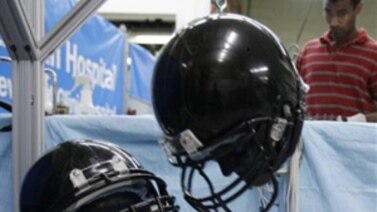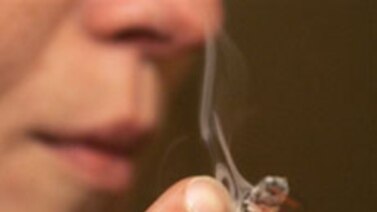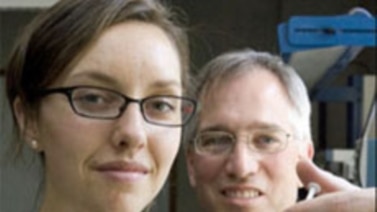BOB DOUGHTY: This is SCIENCE IN THE NEWS, a program in VOA Special English. I’m Bob Doughty.
SHIRLEY GRIFFITH: And I’m Shirley Griffith. Today we tell about the development of what scientists are calling a synthetic cell – a cell produced by people instead of by nature.
(MUSIC)
BOB DOUGHTY: Ten years have passed since the announcement of the first version of the human genome. In two thousand, then-President Bill Clinton told the world that international and private groups had identified the genetic structure of a human being. The president praised scientists working with the Human Genome Project and Celera Genomics Corporation. He said they had organized a design that shows all the information that makes up a human life.
Experts welcomed the announcement as a major development toward the understanding, identification and treatment of disease. They predicted progress against genetic diseases like cystic fibrosis and Parkinson’s disease.
SHIRLEY GRIFFITH: Tony Blair, then the prime minister of Britain, joined President Clinton in Washington for the announcement. The event came after negotiations involving the international and private-laboratory scientists.
Francis Collins led the international group from his position at America's National Institutes of Health. J. Craig Venter led the private laboratory efforts at Celera. The two men denied they were competing. However, observers said the negotiations clearly settled the race to be first.
Three years later, the Human Genome Project announced an almost-completed human genome. Mister Venter’s laboratory announced a different, completed version in two thousand seven.
BOB DOUGHTY: Today, Mister Venter is head of the J. Craig Venter Institute. He has continued his genetics work to carry out another highly publicized project. He and his research team have developed a synthetic, or manmade, cell he calls “Synthia.” A recent report in Science magazine describes the development of the cell.
Mister Venter says Synthia is a new species. He says it is the first cell whose parent was in a computer. He says his team changed existing life into new life because the synthetic cell can control and reproduce a living cell.
To many people, the ability of a cell to reproduce itself is the definition of life itself.
(MUSIC)
SHIRLEY GRIFFITH: The goal of the Venter team's research is to create bacteria designed to solve problems in medicine and energy production. They hope that future synthetic cells can make useful bacteria for products like bio-fuels or vaccines, and to clean up polluted water.
Scientists Daniel Gibson, Hamilton Smith and Mister Venter worked with more than twenty other researchers to develop Synthia. The project took fifteen years and cost forty million dollars.
The cell is made from a synthetic genome. To make that genome, the researchers replaced all the natural genetic material in a bacterial cell with a synthetic set of genes. At the announcement of the cell's creation, Mister Venter described the steps his team followed to develop Synthia.
CRAIG VENTER: “We are here today to announce the first synthetic cell -- a cell made by starting with the digital code in the computer, building the chromosome from four bottles of chemicals, assembling that chromosome in yeast, transplanting it into a recipient bacterial cell and transforming that cell into a new bacterial species.”
(MUSIC)
BOB DOUGHTY: Craig Ventner's research team used a simple natural bacterium that infects goats. It is called Mycoplasma mycoides. The team says the bacterium was changed so it cannot cause harm if it escapes. All the information in its genes is organized into more than one million letters. The letters of this code tell what qualities the bacterium contains.
The researchers placed the coded letters in a computer. Then they made small changes to the bacterium’s deoxyribonucleic acid -- DNA for short. DNA makes chemicals in cells.
The researchers removed four thousand letters. Their removal stopped two genes from operating. Then the team replaced ten genes with four sequences, or four sets, of organized DNA. The researchers call the four sets “watermark” sequences. Each watermark has more than one thousand letters. The coded letters contain people’s names, famous sayings and a website to help identify the cell.
CRAIG VENTER: “And we also built in a website address so that if somebody decodes the code within the code, they can send an e-mail to that address. So it’s clearly distinguishable from any other species.”
SHIRLEY GRIFFITH: Mister Venter says his team made each watermark sequence with the contents of four different bottles of chemicals. The chemicals changed the DNA of each watermark. The DNA particles were designed so pieces next to each other contained eighty letters that overlapped, with one placed over the other. That design provided the pieces with special places to link together.
The researchers added the changed DNA to yeast -- a simple, single-cell organism. Inside the yeast cell, the yeast machinery recognized that the two DNA pieces had the same order. The yeast machinery put them together at this place of overlap.
The genome was created in three steps. When finished, the cell contained more than one million letters. Its creators said it is the longest chemically designed DNA structure ever produced in a laboratory.
BOB DOUGHTY: The researchers placed the genome into a receiving cell of a bacterium called Mycoplasma capricolum. They made the genome active in the bacteria. But first, Mister Venter said, they had to de-activate a gene in the receiving cell that would have killed the synthetic genome.
In late March, the synthetic genome started to produce a new form of cells.
(MUSIC)
SHIRLEY GRIFFITH: To some scientists, the work of Craig Venter's research offers hopeful possibilities. For example, Mister Venter is working to design cells that can make it easier to capture carbon dioxide. His team is also attempting to produce new food oils and make synthetic parts of every known influenza virus. The process may help build new vaccines much faster than is done now.
However, some people see other, far less pleasant possibilities for the new technology. The environmental activist group Friends of the Earth says it is dangerous. The group says it could be hard to stop experimental organisms from entering the natural environment.
It says the synthetic cells might take control of living things in nature. Friends of the Earth has called for suspending further research until rules are made for the technology.
BOB DOUGHTY: University of Pennsylvania professor Arthur Caplan is bioethicist -- an expert in ethical and moral issues of biological medicine and technology. He says the new cell is one of the most important scientific gains ever made. Professor Caplan also believes that concerns about the possible escape of manufactured cells into the atmosphere are real.
Mark Bedau of Reed College in Oregon says Mister Venter’s work marks an important step over traditional genetic engineering of individual genes. But Professor Bedau says that nobody can be sure about the results of making new forms of life. He says science must expect results that are unexpected and unmeant.
President Obama has ordered a report about the possible risks of the technology.
Also, some people may find that manufactured cells threaten their belief that only God should create life. But Nobel Prize-winning scientist David Baltimore says the team created only a representation of real life. Mister Baltimore is a former president of the California Institute of Technology.
SHIRLEY GRIFFITH: Other scientists praise the Venter team’s amazingly big piece of DNA. Still others question whether the cell and those to follow can really help improve health and make biofuels.
Divided opinions of his work are not new to Craig Venter. Over the years, he has sometimes earned enemies by expressing opinions that offend other scientists.
Mister Venter will be sixty-four years old in October. At that age, many people are retired. But he is hard at work. He and his team currently are trying to make algae that can change carbon dioxide back into fossil fuel.
(MUSIC)
BOB DOUGHTY: This SCIENCE IN THE NEWS was written by Jerilyn Watson. Our producer was Mario Ritter. I’m Bob Doughty.
SHIRLEY GRIFFITH: And I’m Shirley Griffith. Join us again next week for more news about science in Special English on the Voice of America.



